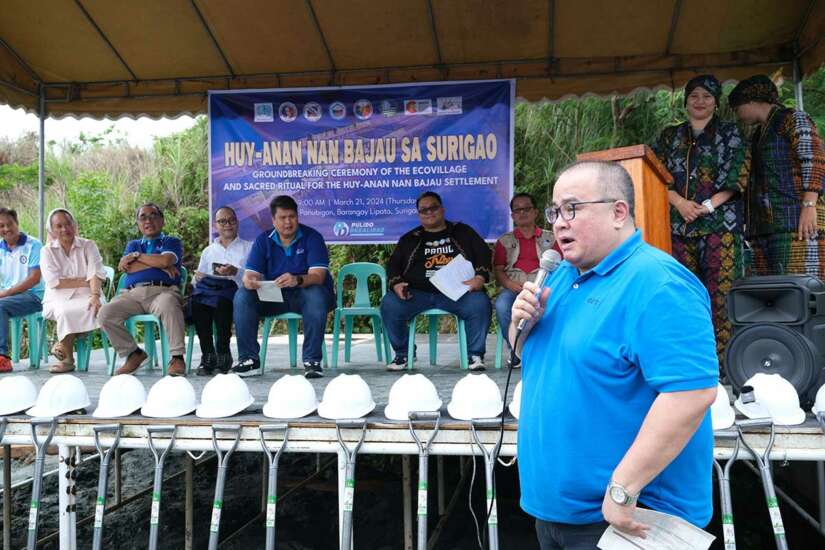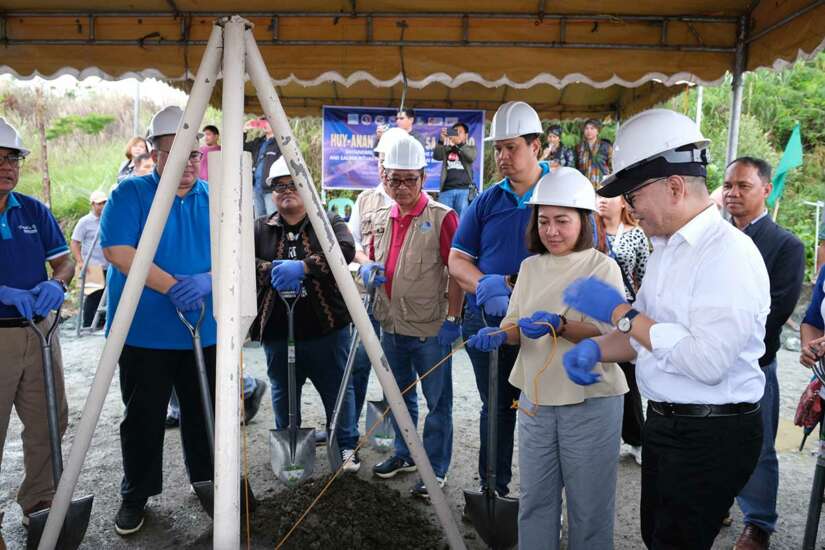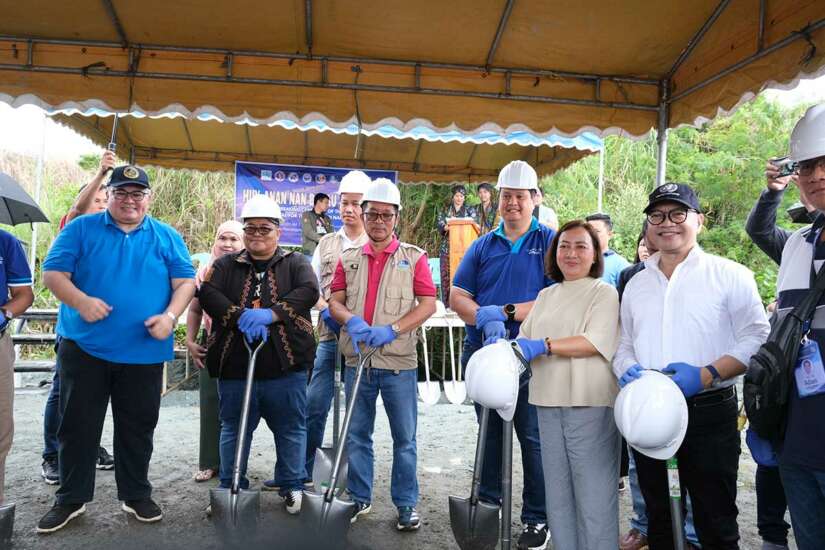Bobby and Elsa Sapayani have been raising their family in the coastal area of Canlanipa, Surigao City. Like many Bajau families in their tribe, their shelter stands on stilts on coastal waters. They have a floor made of bamboo strands, a wrap-around tent as the wall, and nipa as the roof. Together with their eight children, they have been living in this one-room house for more than 20 years now.
When Typhoon Rai (Odette) hit Surigao in 2021, many homes in their community were heavily destroyed. Tending for his family, Bobby temporarily rebuilt their house using basic materials through support from various agencies.
Today marks a new hope for Bobby and Elsa as UN-Habitat’s Huy-anan nan Badjao sa Surigao Project reaches a milestone with the groundbreaking and sacred ritual ceremony held at Brgy. Lipata, Surigao City on March 21.
Formally tagged as Supporting Blue-Green Recovery, Sustainable Growth in Philippine Cities and Communities through Nature-Based Solutions and Circular Economy, the project is implemented by UN-Habitat Philippines and funded by the Government of Spain through the Spanish Agency for International Development Cooperation (AECID).
Government partners for the project include the Provincial Government of Surigao del Norte, City Government of Surigao, Department of Human Settlements and Urban Development (DHSUD), and Department of Environment and Natural Resources (DENR).
Bobby and Elsa’s family is one of the initial 30 households selected as home partners for the project who will receive permanent shelters for the Sama-Bajau community.
Considering the cultural identity of the Bajaus as a sea-based indigenous tribe, the resettlement site will still be located on the coastal waters of the community. In doing this, the project will ensure resilient design solutions based on nature, provide accessible open public spaces, integrate circular economy principles, and incorporate culturally sensitive design in the reconstruction process.
Ritual and groundbreaking

The ceremony on Thursday highlighted a sacred ritual called “aguno” led by the elders of the Bajau community, an act of offering prayers to usher blessing in the indigenous group’s new home.
The ritual also coincided with the groundbreaking activity for the Ecovillage, a joint development with Surigao City and DENR. The identified resettlement area for the Sama-Bajaus is a portion of DENR’s proposed Ecovillage in Brgy. Lipata where 2.13 hectares was allotted as space for the initial 40 Bajau settlement structures.
“We are making history in this project. This will be a model initiative in helping Bajau communities not just in Surigao but all over the country,” Surigao City Mayor Pablo Yves Dumlao II emphasized.
Mayor Dumlao also pointed out that effective collaboration has been the key in pushing forward the progress of the project as many agencies have committed not just to building the Bajau homes but also to providing livelihood support and technical capacities for the project.
“They are Bajaus and they are also our brothers,” said Surigao del Norte Gov. Robert Lyndon Barbers during the ceremony on Thursday as he enjoined stakeholders to support the indigenous group while emphasizing his commitment to support the Bajaus especially in difficult times.

Meanwhile, UN-Habitat Philippines Country Programme Manager Christopher Rollo encouraged continuous support from the LGUs and national government agencies in fast-tracking the site development to facilitate the building of houses, community facilities, and other livelihood support within 2024.
“We remain strong in our commitment to support the city and the Bajau community in this project and the other complementary initiatives to promote a holistic and integrated approach for sustainable and inclusive development,” added Rollo.

Also present at the event are DHSUD-CARAGA Regional Director Cristie Reyes, DENR-CARAGA Regional Director Nonito Tamayo, National Commission on Indigenous Peoples – CARAGA Regional Director Ferdausi Cerna, and regional representatives from Mindanao Development Authority, and TESDA.
Selection process for project homepartners
After a careful selection process facilitated by UN-Habitat and multistakeholder partners, 30 Bajau families are now named in the initial list of homepartners who are eligible to receive permanent shelters in the Huy-anan nan Bajau sa Surigao resettlement site.
This initial list was posted on the Bajau community area and families were given opportunities to provide feedback via complaint forms or personal visits to the UN-Habitat office.
Additional Bajau families are expected to be included in the homepartners list after another round of validation in the second quarter of 2024.
Establishing the Bajau homeowners association
Empowering the Bajaus to steward and build their community in the resettlement site, the Sama-Bajau Magdakayo Homeowners Association, Inc. was formed through the support of the DHSUD-CARAGA.
This was after DHSUD and UN-Habitat conducted a workshop on Formation of Homeowners Association and Discussion of Basic Governance and Registration Process for the initial 30 homepartners on March 6-7.
Homepartners also elected officers and a board of directors that will serve as leaders of the homeowners association. Mayor Dumlao led the officers’ oathtaking during the program on Thursday.
DHSUD has also expressed support in continuously building the capacities of the group to prepare them for managing their community.



